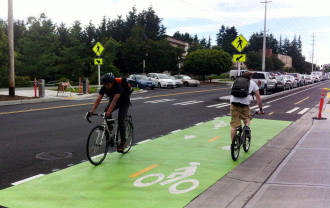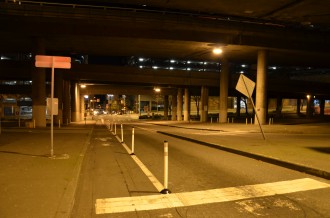
Seattle’s belated entry into protected bike lanes has definitely made a splash. In fact, the national Green Lane Project recently created a list of the top ten protected bike lanes of 2013, and Seattle made the list … twice.
Linden Ave clocked in at 5th, and Cherry Street made the list in the 9th spot. And, notably, Portland made the list zero times.
The Linden Ave Complete Streets project was definitely innovative for a US protected bike lane project. Seattle held no punches, utilizing a wide variety of design elements to create seamless and easy-to-understand bike lanes that feel safe and inviting to more people.
The protected lanes were part of a project aimed at increasing walking safety and ADA accessibility in the growing neighborhood with a large senior population. So Linden is not only a great place to bike, but it is also an excellent demonstration of how protected bike lanes can help make a street more comfortable and safe for everyone whether they bike or not.
The Green Lane Project cites Linden as a world class design inspired by Vancouver, BC. While other cities are building fast and cheap, Seattle is showing what happens when you “do them up nice the first time.”
See video and coverage in our previous post.

The Cherry Street protected bike lanes are short and on a steep hill. They are not flashy or high-budget like the Linden lanes. Indeed, the primary reason they made list is not due to the design: It’s how they came to be.
From the Green Lane Project:
Any other one-block uphill stretch of protected bike lane beneath a highway viaduct, one block from the second-tallest building on the West Coast, would be nothing more than a pretty good idea. But Cherry Street’s protected bike lane makes our list because of who suggested it: a pair of anonymous safety-minded community members calling themselves the “Reasonably Polite Seattlites” who spent $350 of their own money to install these bollards in the dead of night, then sent the city an email to explain why. The coolest thing of all: after removing the temporary installation, city planners realized the activists were right and installed a proper version themselves.
Let’s keep this momentum going. With the complete opening of the Broadway Bikeway coming early next year and plans on the way for miles of protected bike lanes through the downtown core, Seattle is positioned well to keep turning heads and grow its reputation as a top US city for innovative, people-focused streets.








Comments
16 responses to “Seattle makes national list of top ten protected bike lanes in 2013 … twice”
Than why is it so scary to bike in Seattle compared to Portland. Why does not Tacoma get a mention, maybe I only biked the nice parts there but I found bike lanes and it was more mellow than Seattle. Even Spokane feels just as safe as Seattle although I rode around there on a weekend. I was more comfortable riding in Orange County, Ca. Salem, Or is great. There is something wrong with Seattle, something wrong with the mentality of the drivers, or it is such a high pressure city full of high pressure jobs and people rushing to survive against heavy competition. Some of it falls on the police and their hiring practices. They don’t seem to be able to pull people over and write tickets for aggressive driving after following someone through traffic. I know there are some very good policemen out there but I think there are a lot of lazy donut eaters too.
This list isn’t saying Seattle is more bike-friendly than Portland. It’s saying that in 2013, Seattle built two great examples of protected bike lanes (for different reasons). Meanwhile, Portland made few headlines for them in 2013.
I am not super familiar with Tacoma’s bike lanes. Are they building protected lanes? Either way, a cycling in Tacoma feature is a great idea for a story! Thanks.
You’re correct about this, I don’t know if it’s the large number of transplants who come here from less bike oriented areas seeking work or what.. There needs to be a massive mental health campaign directed at people who habitually operate motor vehicles to get them to calm the F down and lose the entitlement mentality.
I guess depending where you bike in Seattle you have a different experience. My bike commute extends from the very cultural diverse Rainier Valley up to Captiol Hill. I notice down here in the hood the Asian community loves my bike riding, especially the older generation. They rode bikes. Then you have the car thumping crazies. You never know what you are going to get so I really just expect this attitude everywhere. Yes, some people act entitled and drive like wackodoos. We also have entitled bicyclist (you know, the kind that can’t unclip themselves and actually stop at the light) and even pedestrians. I mean, what about all those people who decide to cross the light rail track on Martin Luther King or better mosey slowly across Rainier Ave. This city has all sorts. The kids at Alki Kurose play chicken with the light rail and yes, I have complained.
You are right, it does depend on where you bike in Seattle. Somehow the north side is better than the south, even though the north is more congested. If I have to ride down Rainier, it will sure be on the sidewalk. SoDo is not good for bikes. The drivers around the Green Lake area seem more considerate.
I’m skeptical of this false dichotomy between “fast and cheap” and “doing them up nice the first time.” Other cities like Chicago and Washington DC seem to have figured out how to do both at the same time. And Seattle only spent $20,000 on the Cherry St project — that’s pretty cheap (although I suppose “fast” doesn’t really apply). I think we really can have our cake and eat it too. With new SDOT leadership on the way, this is one demand I think we should be making.
Tom, Please explain how the two-way cycle track on Lynden makes life better for pedestrians. Seems like there is a greater risk of collision with a wrong-way cyclist if there weren’t so few cyclists using the street.
Because the crossing distance is now half what it used to be. That’s fewer lanes to walk across, with cars moving at safer speeds. You will find that the data is quite clear here and around the world: Bike lanes and especially protected bike lanes increase safety for people on foot.
Two-way cycletracks do significantly increase bike/pedestrian crash rates in Europe and in other North American cities, but they decrease car/pedestrian crashes. Since car/pededstrian crashes are much more serious, on average, the net effect is a safety improvement for pedestrians. (The greatest increase is where a cycletrack runs behind bus stops, where Copenhagen found a more than 1200% increase in bike/ped accidents.) Denmark now considers this design obsolete and hazardous.
Alta has some pretty good lessons and best practices that address some of these issues here: http://www.altaplanning.com/App_Content/files/pres_stud_docs/Cycle%20Track%20lessons%20learned.pdf
The bus stop problem is largely lessened by making the bus islands wider (something we have to do for ADA purposes, anyway) and making sure there are marked crossing areas for people moving from the stop to the sidewalk. And, of course, if you are on a bike, you are supposed to stop for people crossing.
The document also notes that there is often little separation between the bike lane and sidewalk (remember, they’ve been building these things for decades, and some designs are better than others). We can design protected bikeways in a way so that the separation is more clear.
The Alta doc notes that while one-way protected bike lanes are better, they don’t always fit or situational differences might call for a two-way cycle track (for example, when one side of the street has more destinations or fewer driveways). So it’s all a case-by-case thing.
[…] Seattle makes national list of top ten protected bike lanes in 2013 … twice […]
[…] PeopleForBikes even used a Linden photo to lead its ranking announcement article, which multiple media picked […]
I wikl right awwy grab your rss as I can’t find your email subscription hyperlink or newsletter service.
Do you’ve any? Please permjt mme know so that
I may just subscribe. Thanks.
Here is my website: Temporary Employment Agencies Orange County Ca
[…] Last year, Seattle made the Green Lane Project’s list of the top ten protected bike lanes for 2013 two times: Linden Ave was 5th and Cherry Street was 9th (more for its awesome origin story rather than actual quality). […]
[…] Seattle is a city that is doing everything. Our city makes all the lists of places in the nation that are making smart decisions and getting results.* Best place to get a job? Made that list. Best new protected bike lanes? Made that list. Twice. Again. […]
[…] Cycle Tracks, Locations vary [Image Source: Seattle Bike Blog] […]